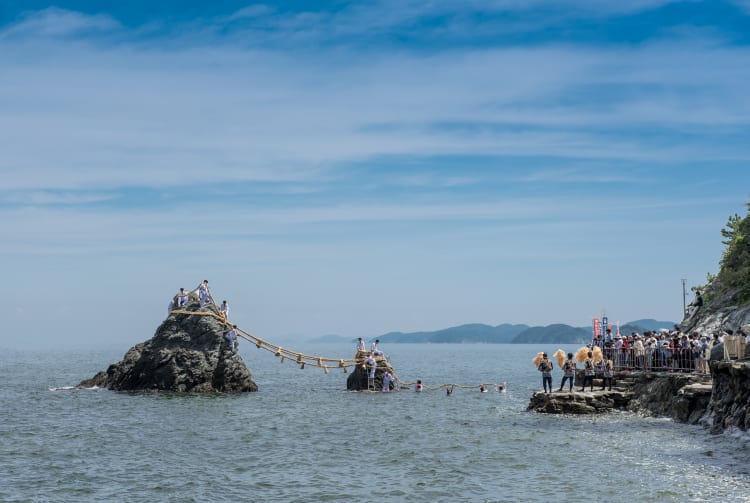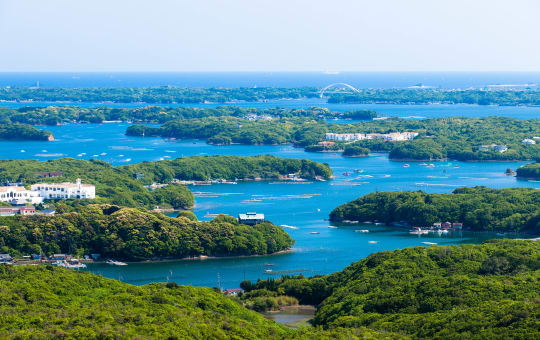Rocas románticas y ranas de la suerte
Si visitas la zona de Mie en pareja, disfruta de una excursión por la costa para admirar el romanticismo y la belleza de los farallones Meoto Iwa o «rocas casadas». Estas rocas sagradas, con conexiones con el sintoísmo, simbolizan al hombre y la mujer y están unidas por una cuerda de paja de arroz, llamada shimenawa, que divide el mundo terrenal y el espiritual.
Datos breves
La roca más grande Otoko-iwa y la más pequeña Onna-iwa están conectados por cinco cuerdas sagradas shimenawa
En verano, los amaneceres son especialmente pintorescos, sobre todo durante el solsticio
Las ranas de un santuario vecino
Cómo llegar
Para llegar a Meoto Iwa, lo mejor es alquilar un coche. Hay zona de estacionamiento gratuita.
Si viajas en tren desde Ise, toma la línea JR Sangu en la estación de Iseshi hasta la estación de Futaminoura. El trayecto dura poco más de 5 minutos. Desde ahí, disfruta de un paseo con vistas espectaculares de unos 15 minutos hasta Meoto Iwa.
Como alternativa, desde las estaciones de JR Iseshi y Kintetsu Ujiyamada hay un autobús que te lleva directo en unos 20 minutos.
Consejos para hacerte fotos
En esta formación rocosa sacarás fotografías inigualables por su ubicación, las mareas y la gruesa cuerda que une los dos farallones.
La mayoría de gente suele visitarla cuando la marea está alta y hay agua entre las dos rocas. En verano, se puede contemplar el amanecer entre las dos formaciones. Y si el día está despejado, se avista incluso el monte Fuji. Durante el mes anterior y posterior al solsticio de verano, se pueden tomar fotos del sol saliendo entre las dos rocas. En las mañanas despejadas de invierno, puedes contemplar el monte Fuji en la lejanía.

Símbolo de la felicidad conyugal
Las rocas Meoto Iwa son conocidas como símbolo de fertilidad y felicidad conyugal por la forma en la que ambas se encuentran una al lado de la otra, unidas por cinco cuerdas sagradas shimenawa. Estas cuerdas se reemplazan tres veces al año, en mayo, septiembre y diciembre.
La roca más grande representa al hombre y la pequeña, a la mujer. Seguramente ahora entiendes por qué se llaman Meoto Iwa o «rocas casadas».

Ranas, fortuna y amor
Amaterasu, la deidad antepasada de la familia imperial, está consagrada en el vecino santuario Ise-Jingu. Bajando por el camino del mirador de Meoto Iwa se encuentra el santuario Futami-Okitama.
Aunque está consagrado a Sarutahiko, líder de los kami terrenales, el santuario destaca por la multitud de ranas que decoran las inmediaciones. Estos animales se consideran de buen augurio ya que su nombre en japonés, kaeru, también significa «volver». Por eso, muchos visitantes piden recuperar cosas o personas que aprecian.

Más allá
Puedes aprovechar la visita a las rocas para visitar el Museo Hinjitsukan, una antigua pensión para la gente VIP que visitaba el santuario Ise-jingu .














































